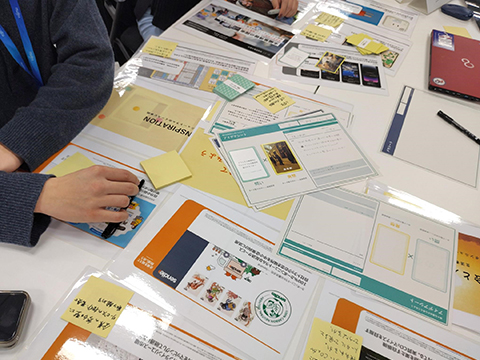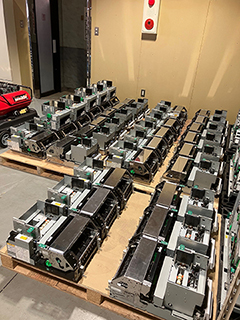Saving and Reusing Resources in Products and Circular Economy Initiatives
Saving Resources in Products and Circular Economy Initiatives
Our Approach
As risks that threaten the sustainability of society and companies continue to rise, such as environmental destruction due to resource depletion and excessive mining, major fluctuations in resource costs around the world, and concerns about the supply of rare metals, the European Commission (EC) has established a new Circular Economy Action Plan (2.0) as a growth strategic pillar of the European Green Deal and is moving forward with measures to accelerate further implementation of resource efficiency into society. For example, the EC has proposed the Circular Electronics Initiative, as well as maintenance for the eco design directive, and is promoting a circular economy through the entire life cycle of products. This is a growing trend all over the world. We believe that from the perspective of recycling resources, it is important for us to make efficient use of the resources in the ICT products that we provide to customers. We have engaged in design that draws on the principles of reduce, reuse, and recycle, and have developed our products with technology that is effective in reducing the amount of resources we use. Given the growing importance of the circular economy worldwide in recent years, we continue to promote the reduction of environmental impact through resource saving while shifting our focus to the realization of the circular economy.
Furthermore, in October 2023, Fujitsu joined the Circular Partners (CPs), a partnership established by Japan’s Ministry of Economy, Trade and Industry to foster collaboration among industry, government, and academia aimed at realizing a circular economy. As part of our ongoing efforts, we aim to reduce our resource intensity —a proprietary metric that indicates the volume of new resources used per revenue across the Fujitsu Group—by 30% or more compared to FY2023 levels. In FY2024, we achieved a 26.5% reduction through resource-saving initiatives. To meet our target, we will continue to drive efforts such as increasing the use of recycled materials to reduce our reliance on virgin resources.

FY2024 Performance
| Targets under the Fujitsu Group Environmental Action Plan (Stage Ⅺ) | FY2024 result |
|---|---|
| Development of products and services that contribute to a circular economy business model | To raise awareness in service development-related departments, Fujitsu implemented an e-learning program for its Japan-based front-line teams, with around 25,000 participants. |
Fujitsu Provided e-Learning Program for Front-line Teams in Japan

As part of our commitment to delivering value to customers and society through circular economy initiatives, the Fujitsu Group provided an e-learning program for front-line teams in Japan. Approximately 25,000 employees received the training. The program covered foundational knowledge of the circular economy, its significance, and its positioning within the Fujitsu Group, as well as approaches that contribute to customers’ business success. In addition, we held a trial session of our Sustainability for Me workshop for internal and external participants. The workshop focuses on transforming sustainability into business opportunities. Through deeper discussions, the session helped generate new opportunities for business engagement.
A new resource goal: “Develop products and services that contribute to a circular economy business model” Established by the Product Business Division
Under Stage X of Fujitsu Group Environmental Action Plan, we have been uniformly promoting resource saving and resource efficiency (*1) improvement for all products. The goal of Stage XI is to develop products and services that contribute to a circular economy business model. To achieve this goal, we will pursue a shift from a one-time purchase model to a service type business model or new business models.
- *1: Resource Efficiency is our own index calculated by dividing the product value by the environmental burden from resource usage and disposal of each material (resource) that makes up the product.
Each Product Business Division Is Driving Efforts to Achieve Its Own Goals
The Product Design and Development Divisions played a leading role in organizing briefings and workshops on the circular economy business, and the Product Business Divisions have set targets in accordance with the Fujitsu Group Environmental Action Plan (Stage XI). At present, efforts are underway to achieve those targets.
Looking Ahead
Going forward, we will work to make the Fujitsu Group’s initiatives more visible by using concrete indicators, while also setting more ambitious targets and driving efforts to achieve them.
Examples of Initiatives in FY2024
Development of a reuse program for ATM maintenance parts (Fujitsu Frontech)

When we replace our customers' ATMs, we take back old ATMs that would normally be scrapped and refurbish some of the parts to be used as maintenance parts. This reduces the number of newly manufactured maintenance parts, thereby limiting the use of new resources and helping to reduce waste.
Product Recycling
Our Approach
The Fujitsu Group's recycling activities are based on the concept of Extended Producer Responsibility (EPR), which holds producers responsible for product design and manufacturing as well as disposal and recycling, and the concept of Individual Producer Responsibility (IPR), which holds a company responsible for its own products. Fujitsu is certified for area-wide disposal of industrial waste based on the Act to Promote Effective Utilization of Resources in Japan. In accordance with these concepts, Fujitsu Recycling Centers around Japan are entrusted to properly dispose of industrial waste, and one of Fujitsu’s voluntary management indicators is "to reuse at least 90% of the resources in its ICT products for businesses."
Changes in Resource Reuse Rates of End-of-life Business ICT Products
93.6 %
94.1 %
93.3 %


